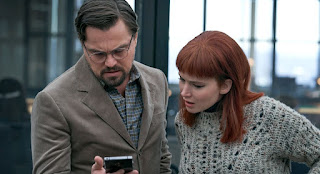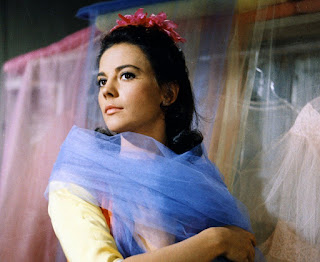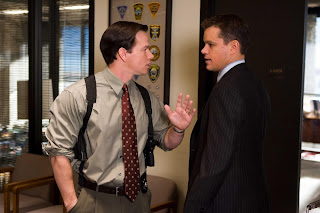With five Academy Award nominations and a win for “The Revenant,” Leonardo DiCaprio has established himself as a Hollywood icon, with nearly $3 billion dollars of global box office to his name. In “Once Upon a Time in Hollywood,” DiCaprio played a washed-up movie star at the end of his tether — which is perhaps the biggest stretch yet for an actor with such an esteemed pedigree and enviable body of work. Adam McKay’s end-times satire “Don’t Look Up” finds DiCaprio back in the awards conversation for his turn as a flustered astronomy professor heralding a planet-annihilating comet to deaf ears. DiCaprio gets many a chance to chew the scene — including in a few pivotal, “Network”-inspired, blistering monologues about the idiocy of the modern world. Source: indiewire.com
First time around, West Side Story was a musical tragedy. The Broadway stylization of American youth (created by Arthur Laurents, Jerome Robbins, Leonard Bernstein, and Stephen Sondheim) was so empathetic toward rock ’n’ roll and restless urban subcultures that when the film version appeared, adults and teenagers all accepted it. They understood that art made by others could represent universal human experience. But in our millennium, the doomed romance of Polish-American Tony with Puerto Rican Maria (star-crossed lovers translated from Shakespeare’s Romeo and Juliet) no longer embodies a common plea for age, race, and cultural tolerance. Now Steven Spielberg’s version of West Side Story seems to reject what once was genuinely unifying in American popular culture. Spielberg and Tony Kushner, his collaborating screenwriter, set the story in the 1960s, specifically when the Upper West Side of Manhattan was undergoing urban renewal. Slum-clearance signs announce preparation for what is now the Lincoln Center fine-arts space. Spielberg and Kushner’s race-war conceit self-consciously heightens national antagonism; they make America’s racist past inescapable. It is always the 1960s.
The threat of injustice is evident when gangs meet, dancing into their positions with the muscular masculine aggression missing from Robbins’s original choreography. The supercharged threat is Spielberg and Kushner’s way of emphasizing violent rivalry. But by film’s end, there’s no more reference to Lincoln Center and its future dominance as a bastion of Western fine arts (the wrecking balls poised over the dilapidated cityscape were just destruction motifs) because Spielberg and Kushner themselves share those commanding heights. They’re in the process of transforming — demolishing — culture according to Millennial rules. This is an inferior West Side Story because it isn’t an honest update. Having fallen under Kushner’s Communist, anti-American influence, Spielberg sinks to self-parody when he attempts to endear Tony (Ansel Elgort) and Maria (Rachel Zegler) as victims of a harsh society — aliens too gentle for this world. Revising American cultural history this way erases West Side Story’s original, unrepeatable, indisputable impact. The closing song “Somewhere” once inspired many renditions (even a poignant, if unctuous, civil-rights theme by Diana Ross and the Supremes) that felt like secular prayers for humanity. Can we ever be so open or romantic again? Spielberg shrinks the spiritual aspiration that once made his popular art transcendent. First time out, West Side Story functioned as tragedy and cultural triumph. Second time, it’s a woke farce. Source: nationalreview.com
Whereas Rock Culture shown in West Side Story was steeped in hedonism and sensualism (despite its serious and/intellectual aspirations), Folk Movement was about socio-political commitment and/or fidelity to the simple essence of humanity unvarnished with cosmeticizing effect of capitalist consumerism, the main expression of which was advertising that presented idealized images (that were hardly accurate representation of humanity); of course, much of advertising today indulge in anti-idealism, a freak-show that also has little use for the normal spectrum of humanity. The Anti-Ideal is the flipside of the Ideal, both driven more by agenda than any reflection of reality. Ideality presents humanity better than it really is, whereas Anti-Ideality makes it seem worse… but for the perverse twist that the Anti-Ideal is promoted as the higher ideal. Sixties Counterculture fell into the Rousseauean trap. Its adherents and spokespeople really believed that all the problems of the world were the result of repression, organization, hierarchy, management, and order. They fell for the fallacy that, because much harm arose from organized power, order itself must be bad, therefore dissolution into happy disorder would automatically liberate humanity from its problems. Source: unz.com
“If you wanted to be cheerful, or melancholic, or wistful , or thoughtful, or courteous, you simply had to act those things with every gesture, Tom thought. But they were not friends. They didn't know each other. It struck Tom like a horrible truth, true for all time, true for the people he had known in the past and for those he would know in the future: each had stood and would stand before him, and he would know time and time again that he would never know them, and the worst was that there would always be the illusion, for a time, that he did know them, and that he and they were completely in harmony and alike. For an instant the wordless shock of his realization seemed more than he could bear.” ―Patricia Highsmith, The Talented Mr. Ripley (1955)
Whereas Highsmith’s Ripley offers an unusual and fascinating insight into the mind of a genuine amoral narcissistic sociopath, Damon’s Ripley is just a vaguely pathetic criminal of opportunity. What makes Ripley scary in the novel is that he doesn’t feel any emotional at all as he kills–and he certainly doesn’t sob and apologise while he’s bludgeoning/strangling you to death. The fascinating and multi-layered psychology of Highsmith’s Ripley is drained of complexity by Minghella. According to Highsmith, the character of Ripley is not a homosexual. That was just Marge’s jealousy speaking. A lesbian herself, Highsmith certainly had no hang-ups about homosexuality. She just didn’t see Ripley that way. In Minghella’s film, however, Dickie Greenleaf is fearsomely handsome and charismatic, and Tom Ripley doesn’t just fall in love with his money and lifestyle, he falls in love with his persona too. Also, the film is far more adept at making the audience Ripley’s accomplices than Highsmith’s novel. Minghella’s Ripley was brilliantly portrayed by Matt Damon, his character completely plausible as a well-intentioned (at first) and sensitive, if insecure and impulsive, young man who is driven over the edge by being seduced for someone so shallow and boorish as Dickie. The realization that the sympathetically-portrayed and tragic character is in reality a sociopath is a dramatic shock that gets you right in the guts. The timing of Minghella’s movie within three years of the murderous rampage of Andrew Cunanan, in which the fashion designer Gianni Versace was killed, makes one wonder if it’s merely coincidental. Source: unz.com
-Charlie Tozier: In a fight to the death between Leonardo DiCaprio, Edward Norton and Ben Affleck, who do you think would emerge victorious? No weapons.
-Matt Damon: Ben is a lot bigger than those guys, he’s hopelessly uncoordinated, but he is a big dude with a huge reach advantage. Edward Norton is very smart though, so he might think of some brainiac way to pit the others against each other and be the last remaining man. I’m not counting Leo DiCaprio out. I’m just saying I don’t know about Leo. Anyway, Mark Wahlberg would kill all of them.
There is a certain type of hardcore Bostonian that Mark Wahlberg has represented, opposite the more illustrious Bostonian actor Matt Damon. Wahlberg, Damon and Affleck came from rough areas from Boston. Wahlberg grew up in Dorchester, one of the most dangerous areas of the city, whereas Ben Affleck and Matt Damon grew up in Cambridge, which also has conflictive areas, but it's more secure if you are familiar with its environment. Historically, Boston was the scene of several key events of the American Revolution, such as the Boston Massacre, the Boston Tea Party, the Battle of Bunker Hill and the siege of Boston. Upon American independence from Great Britain, the city continued to be an important manufacturing hub, a thriving center of scientific research, as well as a center for education and culture.
To date, households and businesses in Boston claim the highest average rate of philanthropy in the United States. In 1950, Whites represented 94.7% of Boston's population. From the 1950s to the end of the 20th century, the proportion of non-Hispanic Whites in the city declined. In 2000, non-Hispanic Whites made up 49.5% of the city's population, making the city majority minority for the first time. In 2010, the US Census Bureau estimated the non-White population had rebounded with increased Latin American and Asian populations, which indicate a non-Hispanic White population of 47 percent (other reports give even lower figures). Harvard University is an Ivy League University located in Cambridge, Massachusetts. Founded in 1636 and named for its first benefactor, the Puritan clergyman John Harvard, it is the oldest institution of higher education in the United States and among the most prestigious in the world. Matt Damon attended Harvard University from 1988-1992, studying Bachelor of Arts and English. His professor of theatre Anthony Kubiak gave him an A and encouraged him to appear in theater plays. In Harvard Damon wrote the first draft of "Good Will Hunting", and as Damon said later: "I showed it to Ben Affleck and the rest is history."
-Matt Damon: I’m lucky to be the only guy in the house. It’s a man’s dream. The testosterone deficit at home makes me very special: You learn a lot by looking at the world from the female point of view. I do get confused with Mark Wahlberg a lot. I was walking down the street with my kids, and this guy screamed “Mark Wahlberg!” I just kept walking, because I’m not Mark, and he kept screaming “Mark Wahlberg, I see you! Don't walk away! MARK WAHLBERG! WE KNOW IT’S YOU!” and then he runs up to me and he says, “I love your work!” And then this woman comes up, and says “I love your family, tell your brother I said Hi!” So I said “Yes, I’ll tell Donnie Wahlberg you said Hi.” If people are insistent, there is no convincing them I’m not Mark, so I just become him and try to be nice to them. My kids were with me and there’s no easy way to explain that situation to them.
“The Departed" (2006), directed by Martin Scorsese, remains a well-crafted, hugely enjoyable pulp crime flick, that certainly improves on its subject matter, the Hong Kong film "Infernal Affairs." The film's chock-full of pleasures and Matt Damon's performance, while not the most immediate, is the one that lingers long afterwards. Simply put, Damon is astounding, the best he's ever been, and looking back now, it's astonishing that he was overlooked in awards season in favor of co-star Mark Wahlberg. Scorsese finally won that elusive Oscar with this Boston crime thriller that had DiCaprio as a cop infiltrating the mob and Matt Damon as a mobster mule infiltrating the police force. It’s an intricate, fascinating tale of competing cat-and-mouse games, but the director and his screenwriter, William Monahan, infuse it with so much tragedy that it winds up becoming something almost mythic. Source: rollingstone.com














No comments :
Post a Comment